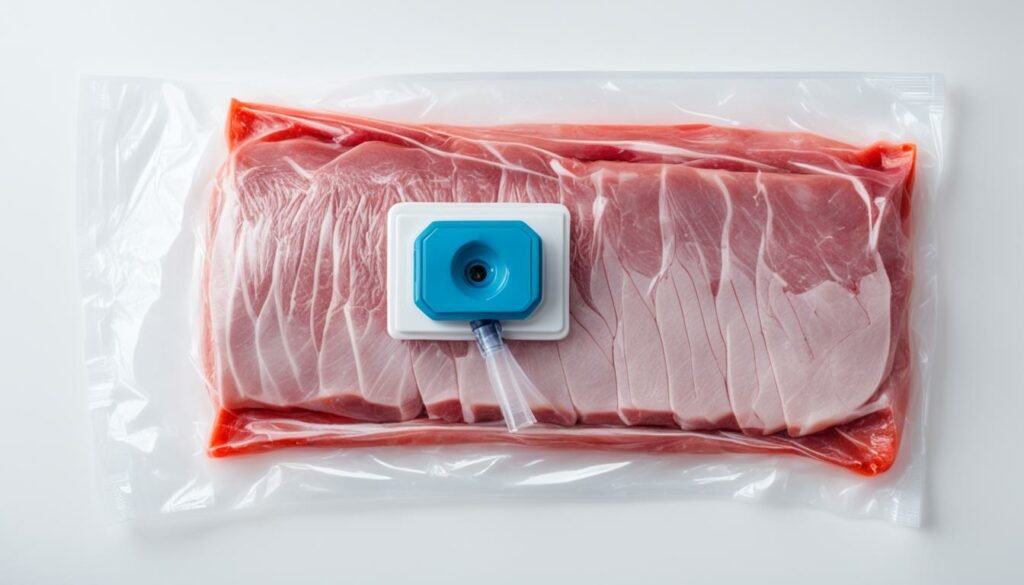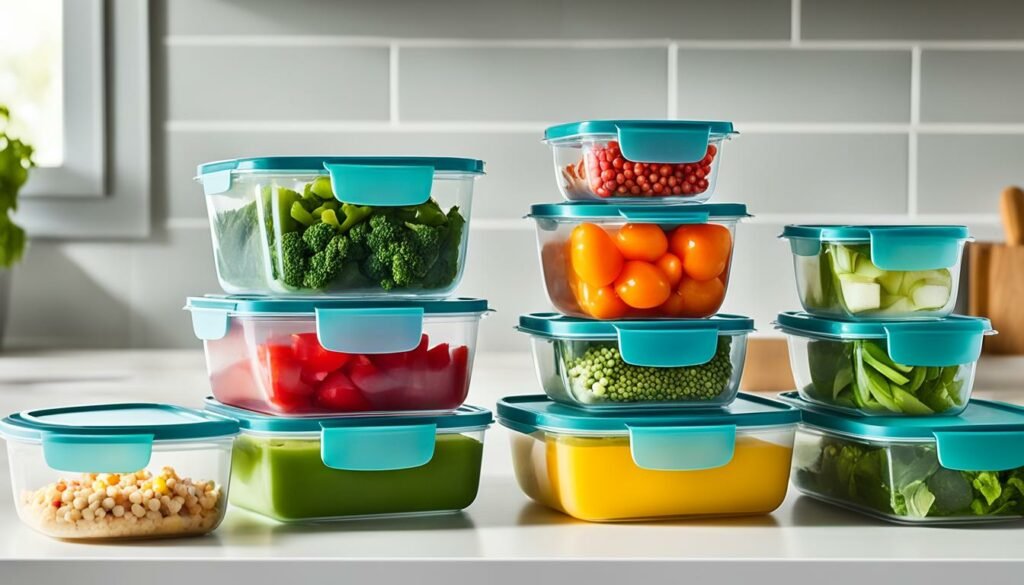The evolution of food preservation has been remarkable. We’ve moved from traditional methods like root cellars and smokehouses to advanced techniques. Today, we favor high-tech solutions such as vacuum packaging and airtight containers like Tupperware. But which is superior for our kitchens?
This article delves into the realm of modern food storage solutions. We’ll examine how vacuum packaging and Tupperware compare in maintaining food quality and extending its shelf life. Additionally, we’ll discuss their effects on kitchen organization and your budget. By the conclusion, you’ll understand which option suits your food storage requirements best.
Let’s dissect the advantages and disadvantages of vacuum packaging and Tupperware. Discover which method ensures your meals remain fresh for longer!
Introduction to Modern Food Storage Methods
Food preservation techniques have evolved significantly over time. I’ve witnessed firsthand the transformation from ancient salting to modern vacuum sealing. These advancements have greatly improved our ability to keep food fresh for longer periods.
The Evolution of Food Preservation
Early humans employed basic methods such as drying and fermenting to preserve food. Today, we utilize advanced techniques like freezing, canning, and chemical preservatives. These methods are designed to halt spoilage and preserve nutrients effectively.
The Importance of Proper Food Storage
Proper food storage is essential. It minimizes waste, conserves finances, and ensures our families’ health. Effective storage involves controlling moisture and maintaining freshness. By managing temperature and humidity, we can slow bacterial growth and uphold food quality.
Overview of Vacuum Packaging and Tupperware
Vacuum packaging and Tupperware are two prevalent storage solutions today. Vacuum packaging eliminates air, creating an environment devoid of oxygen. This approach slows down spoilage and prevents freezer burn. Tupperware, with its reusable containers, seals tightly to maintain freshness.
| Method | Principle | Best For |
|---|---|---|
| Vacuum Packaging | Air removal | Meats, cheese, dry goods |
| Tupperware | Airtight seal | Leftovers, fruits, vegetables |
Both vacuum packaging and Tupperware are integral to modern kitchens. They cater to different food storage requirements. Understanding these techniques empowers us to make informed decisions about food preservation.
Understanding Vacuum Packaging
Vacuum packaging has transformed the way we store food. It has been a significant improvement in my kitchen. This method removes air from containers or bags before sealing, which is crucial for maintaining food quality.
How Vacuum Packaging Works
The vacuum sealing process is straightforward yet highly effective. First, food is placed in a specialized bag or container. Then, a machine is used to extract the air. This action creates a tight seal, preventing oxidation and keeping food fresh for longer periods.

Types of Vacuum Packaging Systems
There’s a variety of vacuum packaging systems available:
- Basic models ($40-$100): Ideal for home use
- Mid-range systems ($100-$300): Feature more functionality and durability
- Professional models ($300+): Suitable for heavy-duty use or commercial settings
Benefits of Vacuum Sealing Food
Vacuum sealing provides numerous benefits for preserving food:
| Benefit | Description |
|---|---|
| Extended shelf life | Foods can last up to 5 times longer |
| Improved food quality | Preserves color, texture, and flavor |
| Prevention of freezer burn | Protects food from ice crystal damage |
| Space efficiency | Reduces package size, saving storage space |
| Protection against contaminants | Shields food from bacteria and mold |
The process of removing oxygen through vacuum sealing is particularly effective for preserving meats, vegetables, and other foods meant for freezer storage. It’s a dependable method for ensuring food quality remains intact over extended periods.
Exploring Tupperware and Traditional Food Storage
I find reusable containers essential for organizing food. They are not only convenient and affordable but also eco-friendly. Brands like Tupperware offer a variety of shapes and sizes to meet diverse needs.

- Budget-friendly options
- Eco-friendly due to reusability
- Versatile for different foods
- Easy to clean and maintain
These containers excel for short-term storage but may not extend food shelf life as effectively as vacuum packaging. Exposure to air can degrade food quality and cause freezer burn.
| Feature | Tupperware | Vacuum Packaging |
|---|---|---|
| Reusability | High | Low |
| Initial Cost | Low | High |
| Long-term Preservation | Moderate | Excellent |
| Versatility | High | Moderate |
For the best food organization, combining methods is advisable. Tupperware suits daily meals, while vacuum packaging is best for storing bulk items or leftovers over extended periods.
Vacuum Packaging vs. Tupperware: A Comprehensive Comparison
In my quest for the perfect food storage comparison, I’ve explored various methods. Let’s dive into how vacuum packaging and Tupperware stack up against each other in key areas.
Shelf Life Extension
Vacuum packaging is a clear winner when it comes to shelf life. By removing air, it significantly slows down food spoilage. In my experience, vacuum-sealed meats can last up to 3 times longer in the freezer compared to traditional storage methods.
Space Efficiency and Organization
Both options offer space-saving solutions, but in different ways. Vacuum-sealed bags are flat and compact, perfect for maximizing freezer space. Tupperware, while bulkier, excels in pantry organization with its stackable design.
Cost Considerations
The initial investment for a vacuum sealer is higher, but it can lead to long-term savings by reducing food waste. Tupperware is more budget-friendly upfront, making it a popular choice for many households.
Environmental Impact
Tupperware wins in sustainability. Its reusable nature aligns with eco-friendly practices. Vacuum bags, often single-use, create more waste. However, some brands now offer reusable vacuum bags, bridging this gap.
| Feature | Vacuum Packaging | Tupperware |
|---|---|---|
| Shelf Life | Excellent | Good |
| Space Efficiency | Very High | High |
| Initial Cost | High | Low |
| Eco-Friendliness | Low to Moderate | High |
Pros and Cons of Vacuum Packaging
Vacuum packaging has become increasingly popular, offering distinct advantages for food preservation. A primary benefit is the substantial increase in food shelf life. By eliminating air from the packaging, it hinders bacteria and mold growth, ensuring food remains fresh for extended periods.
Preventing freezer burn is another significant advantage. Vacuum sealing meats and vegetables before freezing helps preserve their quality and flavor. This method also maximizes freezer and pantry space, as the sealed packages are more compact.
Yet, there are drawbacks to consider. The initial cost of a vacuum sealer and specialized bags can be prohibitive. Moreover, not all foods are compatible with vacuum sealing. Soft fruits and vegetables may be crushed, and certain cheeses can inflate the bags due to gas release.
Here’s a detailed look at the pros and cons I’ve encountered with vacuum packaging:
| Pros | Cons |
|---|---|
| Extended shelf life | High initial cost |
| Prevents freezer burn | Not suitable for all foods |
| Space-saving | Time-consuming process |
| Protects against contaminants | Limited reusability of bags |
While vacuum packaging provides notable benefits for long-term storage and freezer use, it might not be ideal for everyday use. It’s crucial to evaluate these factors against your specific food storage needs before deciding on a vacuum sealing system.
Advantages and Disadvantages of Tupperware
Tupperware has become synonymous with plastic container storage in many homes. It offers numerous benefits that make it a favored choice for families. Let’s delve into the advantages and disadvantages of this classic food storage solution.
Convenience and Versatility
Tupperware stands out for its convenience. Its variety of shapes and sizes is ideal for storing various foods. Whether it’s leftovers or snacks, there’s a container for every need. This versatility simplifies meal preparation and keeps things organized.
Durability and Reusability
One of Tupperware’s standout features is its durability. These containers endure repeated use and cleaning without losing their shape or seal. I’ve owned some for years, and they continue to perform well. This durability positions Tupperware as an eco-friendly option for storing food.
Limitations in Food Preservation
Despite its strengths, Tupperware has limitations in preserving food for extended periods. Unlike vacuum sealing, it doesn’t eliminate air from the container. This can result in faster spoilage and potential freezer burn for frozen items.
| Feature | Tupperware | Vacuum Packaging |
|---|---|---|
| Air Removal | No | Yes |
| Long-term Freshness | Moderate | Excellent |
| Reusability | High | Limited |
| Versatility | High | Moderate |
In my experience, Tupperware is perfect for everyday use and short-term storage. It maintains food freshness for a decent period and aids in keeping the fridge or pantry organized. However, for long-term preservation of meats or produce, other methods might be more effective.
Conclusion: Making the Right Choice for Your Food Storage Needs
When evaluating food storage options, both vacuum packaging and Tupperware stand out. Vacuum packaging excels at maintaining food freshness over extended periods, ideal for bulk storage. Conversely, Tupperware provides swift access and effortless organization for everyday use.
My approach often blends these methods for optimal kitchen efficiency. For instance, I employ vacuum sealing for meats and vegetables purchased in bulk. Meanwhile, Tupperware accommodates my leftovers and packed lunches. This strategy enables me to maintain effective kitchen organization tailored to my lifestyle.
As environmental consciousness grows, it’s crucial to explore eco-friendly alternatives in food storage. Opting for reusable vacuum bags and durable Tupperware containers can drastically cut down on single-use plastic waste. By selecting the appropriate storage solution for each item, we can ensure our food remains fresh, our kitchens remain organized, and our planet benefits from our choices.
FAQ
What is the main difference between vacuum packaging and Tupperware?
Vacuum packaging removes air from containers or bags before sealing, creating an airtight environment. In contrast, Tupperware offers reusable plastic containers that do not remove air.
How does vacuum packaging help preserve food?
Vacuum sealing slows down oxidation, which helps maintain the color, texture, and flavor of foods. It removes air, preventing spoilage and freezer burn. This method extends the shelf life of various items like meats, vegetables, and frozen foods.
What are the advantages of using Tupperware?
Tupperware containers are convenient, versatile, affordable, and eco-friendly. They are reusable and come in various sizes and shapes to meet different storage needs.
Which method is better for long-term food storage?
Vacuum packaging is generally more effective for long-term food storage and preserving quality. It removes air and prevents freezer burn better than traditional methods like Tupperware.
Are there any drawbacks to vacuum packaging?
Some drawbacks of vacuum packaging include the initial cost of purchasing a sealer, limited container options, unsuitability for some foods (those that release gases or have sharp edges), a time-consuming process, and limited reusability of the bags, which can create more waste.
Is Tupperware suitable for freezer storage?
While Tupperware can be used for freezer storage, it may not be as effective as vacuum packaging in preventing freezer burn and preserving food quality over an extended period due to air exposure.
What factors should I consider when choosing between vacuum packaging and Tupperware?
Consider factors like the types of food you store, frequency of use, budget, long-term storage needs, and environmental impact. A combination of both methods may provide the best solution, balancing preservation effectiveness with practicality and eco-friendliness.
Source Links
- https://medium.com/@foodmagazineofficial/vacuum-packaging-vs-traditional-food-storage-pros-and-cons-e7fd5b1134a8
- https://ankomn.com/blogs/news/vacuum-sealers-vs-vacuum-sealed-containers-which-is-better-for-your-food-storage
- https://www.reddit.com/r/MealPrepSunday/comments/uxmplq/tupperware_recommendations_vacuum_sealed/
